Project on Office Relocation: Leadership and Planning
VerifiedAdded on 2022/11/23
|25
|5187
|160
Project
AI Summary
This project report details the relocation of a 250-staff office from Metropolis City Centre to a new business park. The project encompasses choosing a building, refurbishment, and the transfer of staff and equipment, all within a 3-month timeframe and a £50,000 budget. The report includes a PESTLE analysis, work breakdown structure, Gantt chart, risk analysis, RACI matrix, and stakeholder management strategy. It outlines the rationale for the proposed plan, project context, and the different phases of the project, from initial planning to the final relocation and maintenance of the new office space. The report also covers defining requirements, selecting an office site, designing the new office layout, construction activities, building communication networks, interior design, and quality review. The project management tools and strategies are applied to ensure the project's success, including efficient planning, risk mitigation, and stakeholder engagement. The report provides a comprehensive overview of the office relocation project, including the specific requirements for the office space (creating appropriate office space for 5 senior executives, 3 separate teams (finance and payroll (10 staff members), human resources (5 staff members) and call centre operations (230 staff members) along with IT infrastructure). The project is focused on leadership and effective management of the office relocation process.
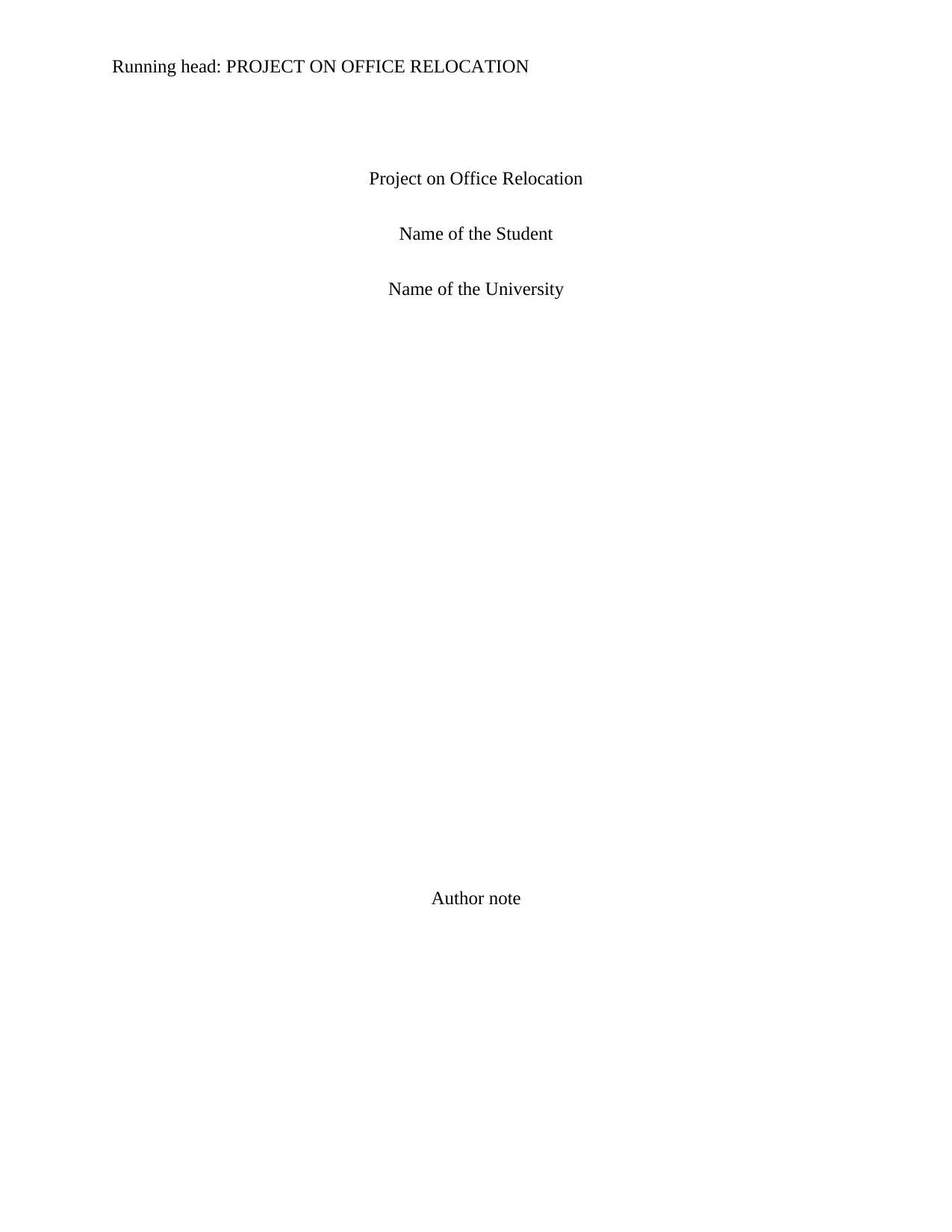
Running head: PROJECT ON OFFICE RELOCATION
Project on Office Relocation
Name of the Student
Name of the University
Author note
Project on Office Relocation
Name of the Student
Name of the University
Author note
Paraphrase This Document
Need a fresh take? Get an instant paraphrase of this document with our AI Paraphraser
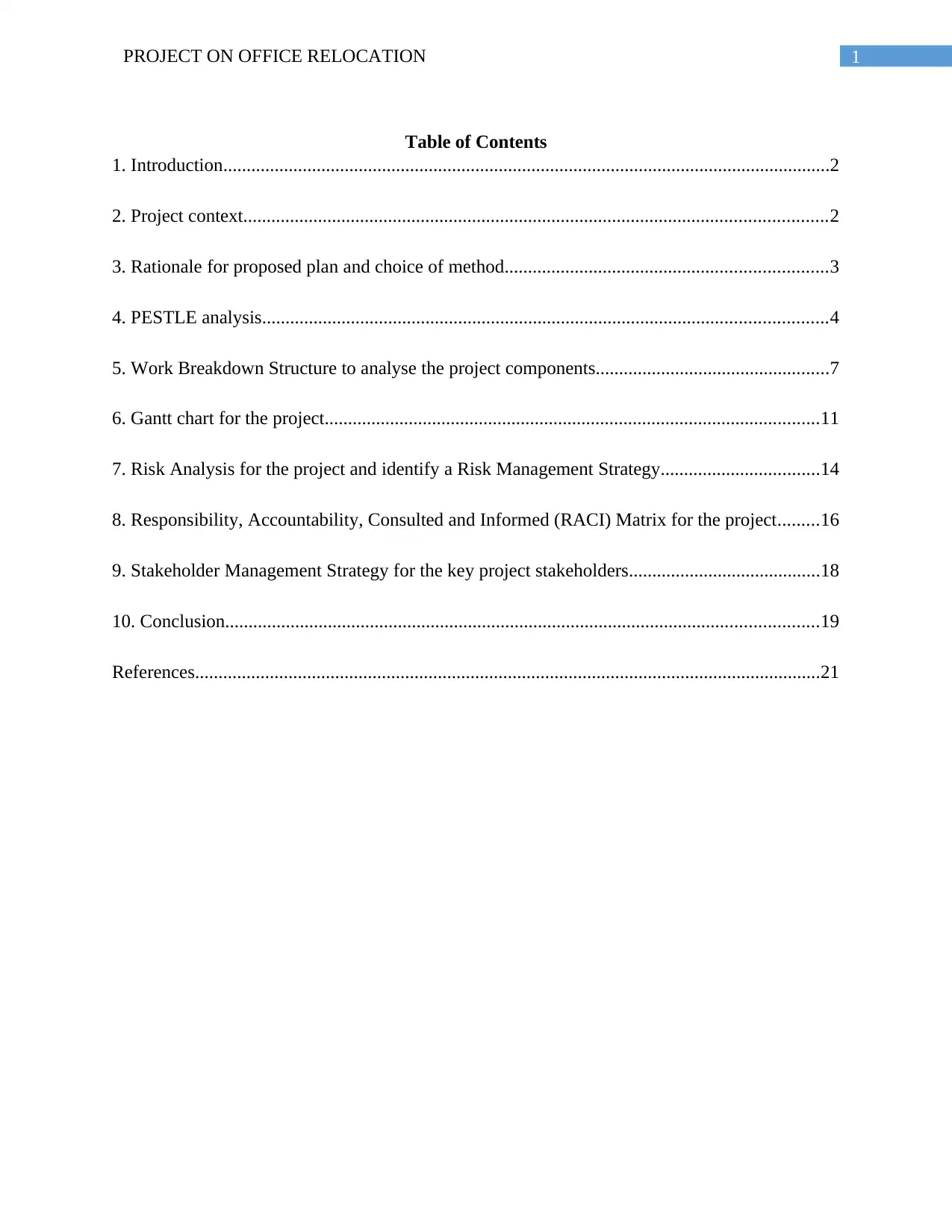
1PROJECT ON OFFICE RELOCATION
Table of Contents
1. Introduction..................................................................................................................................2
2. Project context.............................................................................................................................2
3. Rationale for proposed plan and choice of method.....................................................................3
4. PESTLE analysis.........................................................................................................................4
5. Work Breakdown Structure to analyse the project components..................................................7
6. Gantt chart for the project..........................................................................................................11
7. Risk Analysis for the project and identify a Risk Management Strategy..................................14
8. Responsibility, Accountability, Consulted and Informed (RACI) Matrix for the project.........16
9. Stakeholder Management Strategy for the key project stakeholders.........................................18
10. Conclusion...............................................................................................................................19
References......................................................................................................................................21
Table of Contents
1. Introduction..................................................................................................................................2
2. Project context.............................................................................................................................2
3. Rationale for proposed plan and choice of method.....................................................................3
4. PESTLE analysis.........................................................................................................................4
5. Work Breakdown Structure to analyse the project components..................................................7
6. Gantt chart for the project..........................................................................................................11
7. Risk Analysis for the project and identify a Risk Management Strategy..................................14
8. Responsibility, Accountability, Consulted and Informed (RACI) Matrix for the project.........16
9. Stakeholder Management Strategy for the key project stakeholders.........................................18
10. Conclusion...............................................................................................................................19
References......................................................................................................................................21
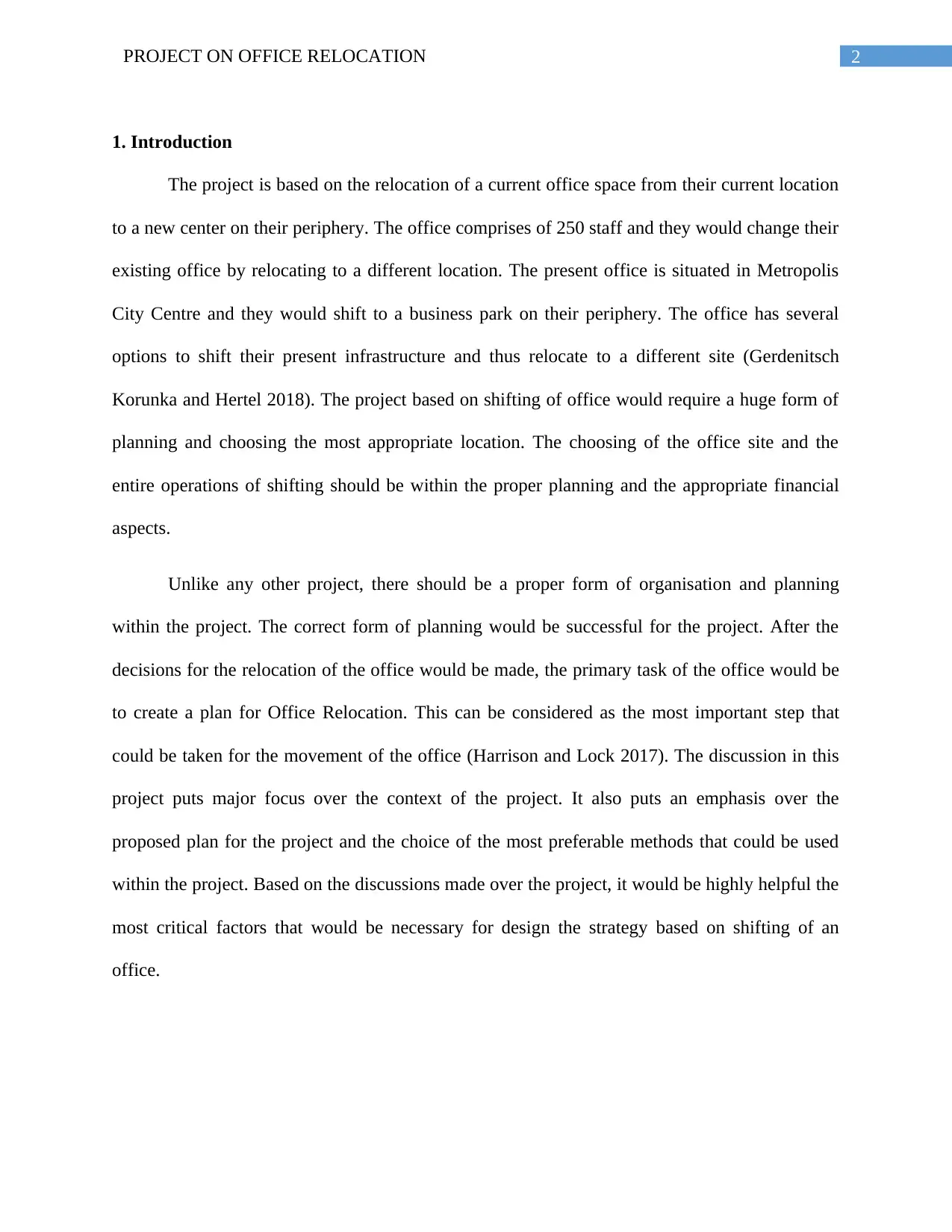
2PROJECT ON OFFICE RELOCATION
1. Introduction
The project is based on the relocation of a current office space from their current location
to a new center on their periphery. The office comprises of 250 staff and they would change their
existing office by relocating to a different location. The present office is situated in Metropolis
City Centre and they would shift to a business park on their periphery. The office has several
options to shift their present infrastructure and thus relocate to a different site (Gerdenitsch
Korunka and Hertel 2018). The project based on shifting of office would require a huge form of
planning and choosing the most appropriate location. The choosing of the office site and the
entire operations of shifting should be within the proper planning and the appropriate financial
aspects.
Unlike any other project, there should be a proper form of organisation and planning
within the project. The correct form of planning would be successful for the project. After the
decisions for the relocation of the office would be made, the primary task of the office would be
to create a plan for Office Relocation. This can be considered as the most important step that
could be taken for the movement of the office (Harrison and Lock 2017). The discussion in this
project puts major focus over the context of the project. It also puts an emphasis over the
proposed plan for the project and the choice of the most preferable methods that could be used
within the project. Based on the discussions made over the project, it would be highly helpful the
most critical factors that would be necessary for design the strategy based on shifting of an
office.
1. Introduction
The project is based on the relocation of a current office space from their current location
to a new center on their periphery. The office comprises of 250 staff and they would change their
existing office by relocating to a different location. The present office is situated in Metropolis
City Centre and they would shift to a business park on their periphery. The office has several
options to shift their present infrastructure and thus relocate to a different site (Gerdenitsch
Korunka and Hertel 2018). The project based on shifting of office would require a huge form of
planning and choosing the most appropriate location. The choosing of the office site and the
entire operations of shifting should be within the proper planning and the appropriate financial
aspects.
Unlike any other project, there should be a proper form of organisation and planning
within the project. The correct form of planning would be successful for the project. After the
decisions for the relocation of the office would be made, the primary task of the office would be
to create a plan for Office Relocation. This can be considered as the most important step that
could be taken for the movement of the office (Harrison and Lock 2017). The discussion in this
project puts major focus over the context of the project. It also puts an emphasis over the
proposed plan for the project and the choice of the most preferable methods that could be used
within the project. Based on the discussions made over the project, it would be highly helpful the
most critical factors that would be necessary for design the strategy based on shifting of an
office.
⊘ This is a preview!⊘
Do you want full access?
Subscribe today to unlock all pages.

Trusted by 1+ million students worldwide
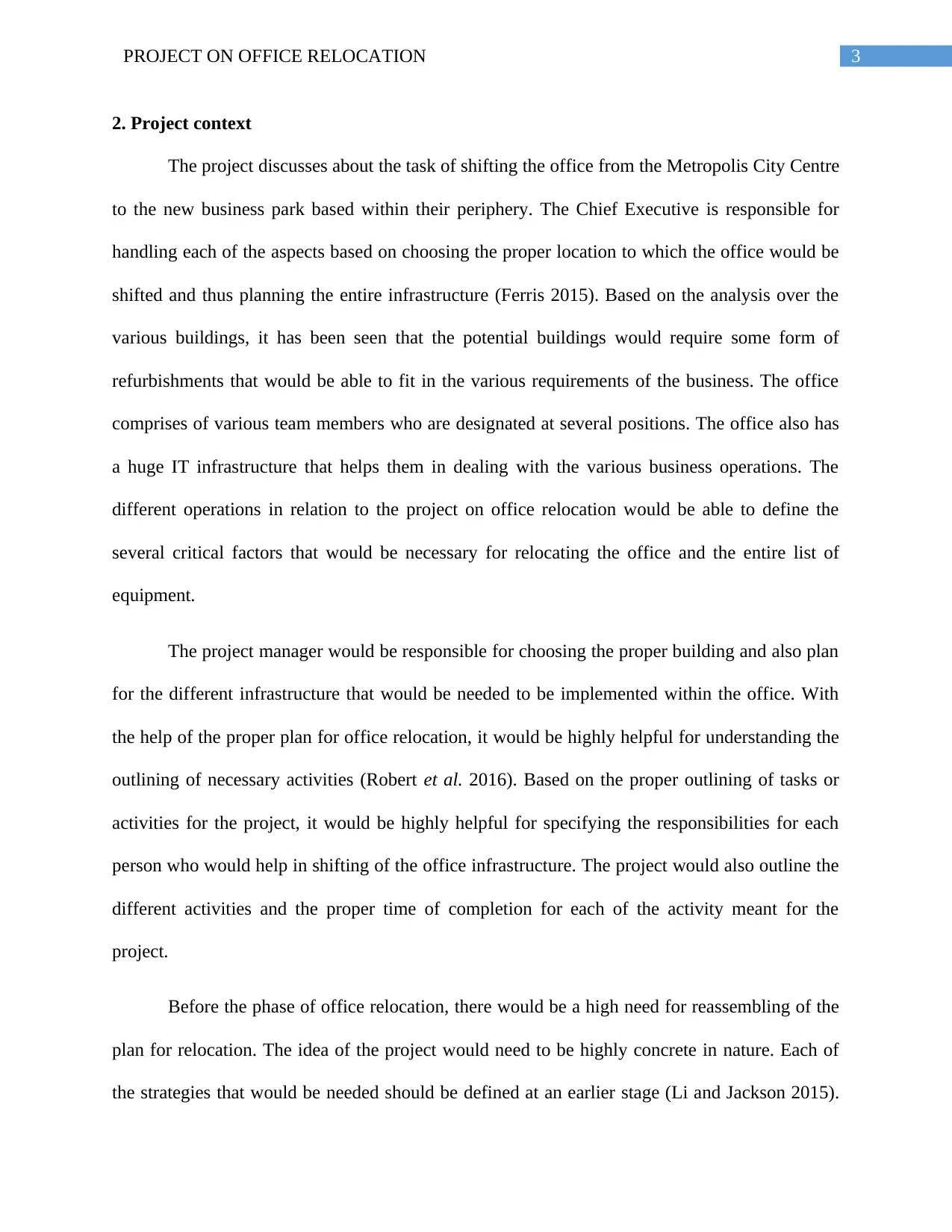
3PROJECT ON OFFICE RELOCATION
2. Project context
The project discusses about the task of shifting the office from the Metropolis City Centre
to the new business park based within their periphery. The Chief Executive is responsible for
handling each of the aspects based on choosing the proper location to which the office would be
shifted and thus planning the entire infrastructure (Ferris 2015). Based on the analysis over the
various buildings, it has been seen that the potential buildings would require some form of
refurbishments that would be able to fit in the various requirements of the business. The office
comprises of various team members who are designated at several positions. The office also has
a huge IT infrastructure that helps them in dealing with the various business operations. The
different operations in relation to the project on office relocation would be able to define the
several critical factors that would be necessary for relocating the office and the entire list of
equipment.
The project manager would be responsible for choosing the proper building and also plan
for the different infrastructure that would be needed to be implemented within the office. With
the help of the proper plan for office relocation, it would be highly helpful for understanding the
outlining of necessary activities (Robert et al. 2016). Based on the proper outlining of tasks or
activities for the project, it would be highly helpful for specifying the responsibilities for each
person who would help in shifting of the office infrastructure. The project would also outline the
different activities and the proper time of completion for each of the activity meant for the
project.
Before the phase of office relocation, there would be a high need for reassembling of the
plan for relocation. The idea of the project would need to be highly concrete in nature. Each of
the strategies that would be needed should be defined at an earlier stage (Li and Jackson 2015).
2. Project context
The project discusses about the task of shifting the office from the Metropolis City Centre
to the new business park based within their periphery. The Chief Executive is responsible for
handling each of the aspects based on choosing the proper location to which the office would be
shifted and thus planning the entire infrastructure (Ferris 2015). Based on the analysis over the
various buildings, it has been seen that the potential buildings would require some form of
refurbishments that would be able to fit in the various requirements of the business. The office
comprises of various team members who are designated at several positions. The office also has
a huge IT infrastructure that helps them in dealing with the various business operations. The
different operations in relation to the project on office relocation would be able to define the
several critical factors that would be necessary for relocating the office and the entire list of
equipment.
The project manager would be responsible for choosing the proper building and also plan
for the different infrastructure that would be needed to be implemented within the office. With
the help of the proper plan for office relocation, it would be highly helpful for understanding the
outlining of necessary activities (Robert et al. 2016). Based on the proper outlining of tasks or
activities for the project, it would be highly helpful for specifying the responsibilities for each
person who would help in shifting of the office infrastructure. The project would also outline the
different activities and the proper time of completion for each of the activity meant for the
project.
Before the phase of office relocation, there would be a high need for reassembling of the
plan for relocation. The idea of the project would need to be highly concrete in nature. Each of
the strategies that would be needed should be defined at an earlier stage (Li and Jackson 2015).
Paraphrase This Document
Need a fresh take? Get an instant paraphrase of this document with our AI Paraphraser
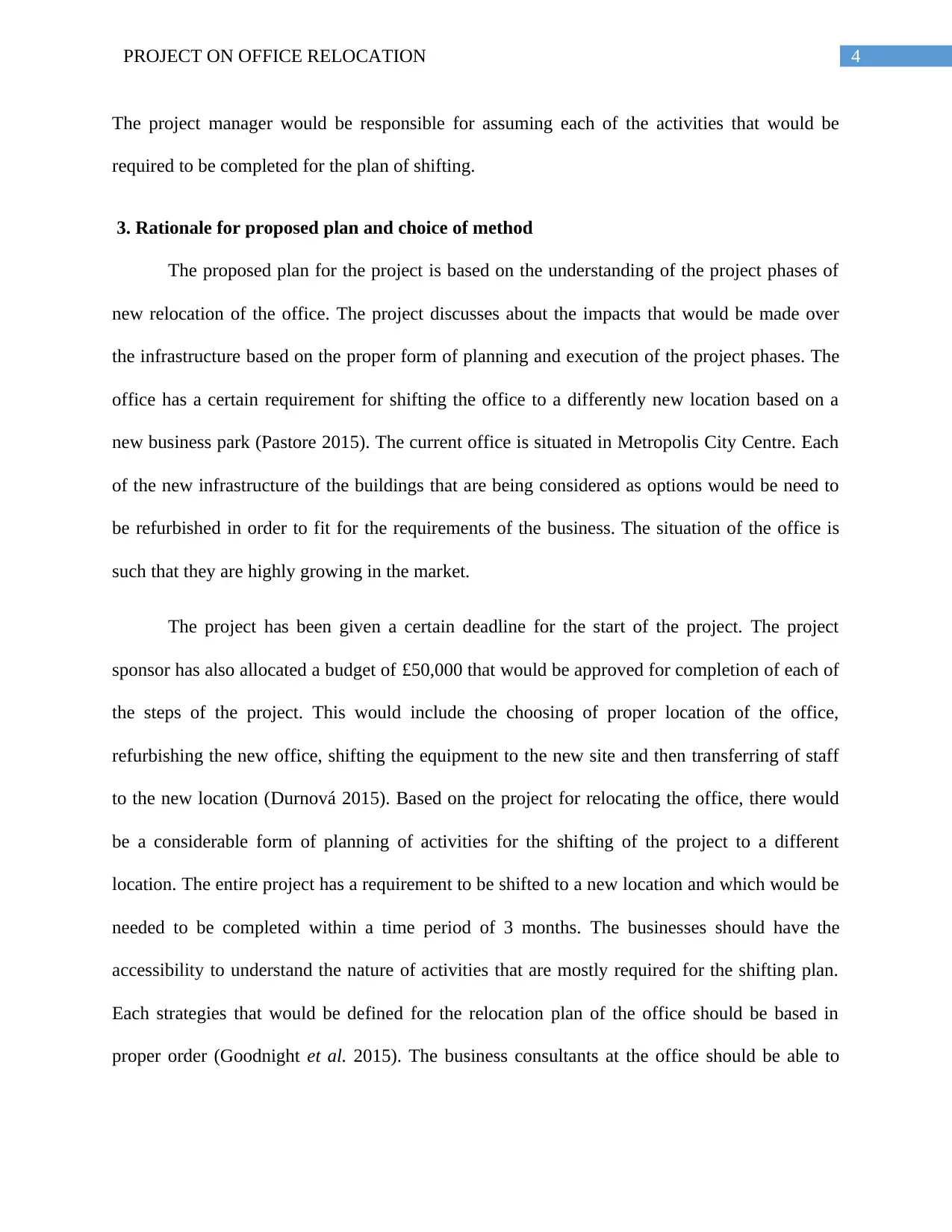
4PROJECT ON OFFICE RELOCATION
The project manager would be responsible for assuming each of the activities that would be
required to be completed for the plan of shifting.
3. Rationale for proposed plan and choice of method
The proposed plan for the project is based on the understanding of the project phases of
new relocation of the office. The project discusses about the impacts that would be made over
the infrastructure based on the proper form of planning and execution of the project phases. The
office has a certain requirement for shifting the office to a differently new location based on a
new business park (Pastore 2015). The current office is situated in Metropolis City Centre. Each
of the new infrastructure of the buildings that are being considered as options would be need to
be refurbished in order to fit for the requirements of the business. The situation of the office is
such that they are highly growing in the market.
The project has been given a certain deadline for the start of the project. The project
sponsor has also allocated a budget of £50,000 that would be approved for completion of each of
the steps of the project. This would include the choosing of proper location of the office,
refurbishing the new office, shifting the equipment to the new site and then transferring of staff
to the new location (Durnová 2015). Based on the project for relocating the office, there would
be a considerable form of planning of activities for the shifting of the project to a different
location. The entire project has a requirement to be shifted to a new location and which would be
needed to be completed within a time period of 3 months. The businesses should have the
accessibility to understand the nature of activities that are mostly required for the shifting plan.
Each strategies that would be defined for the relocation plan of the office should be based in
proper order (Goodnight et al. 2015). The business consultants at the office should be able to
The project manager would be responsible for assuming each of the activities that would be
required to be completed for the plan of shifting.
3. Rationale for proposed plan and choice of method
The proposed plan for the project is based on the understanding of the project phases of
new relocation of the office. The project discusses about the impacts that would be made over
the infrastructure based on the proper form of planning and execution of the project phases. The
office has a certain requirement for shifting the office to a differently new location based on a
new business park (Pastore 2015). The current office is situated in Metropolis City Centre. Each
of the new infrastructure of the buildings that are being considered as options would be need to
be refurbished in order to fit for the requirements of the business. The situation of the office is
such that they are highly growing in the market.
The project has been given a certain deadline for the start of the project. The project
sponsor has also allocated a budget of £50,000 that would be approved for completion of each of
the steps of the project. This would include the choosing of proper location of the office,
refurbishing the new office, shifting the equipment to the new site and then transferring of staff
to the new location (Durnová 2015). Based on the project for relocating the office, there would
be a considerable form of planning of activities for the shifting of the project to a different
location. The entire project has a requirement to be shifted to a new location and which would be
needed to be completed within a time period of 3 months. The businesses should have the
accessibility to understand the nature of activities that are mostly required for the shifting plan.
Each strategies that would be defined for the relocation plan of the office should be based in
proper order (Goodnight et al. 2015). The business consultants at the office should be able to
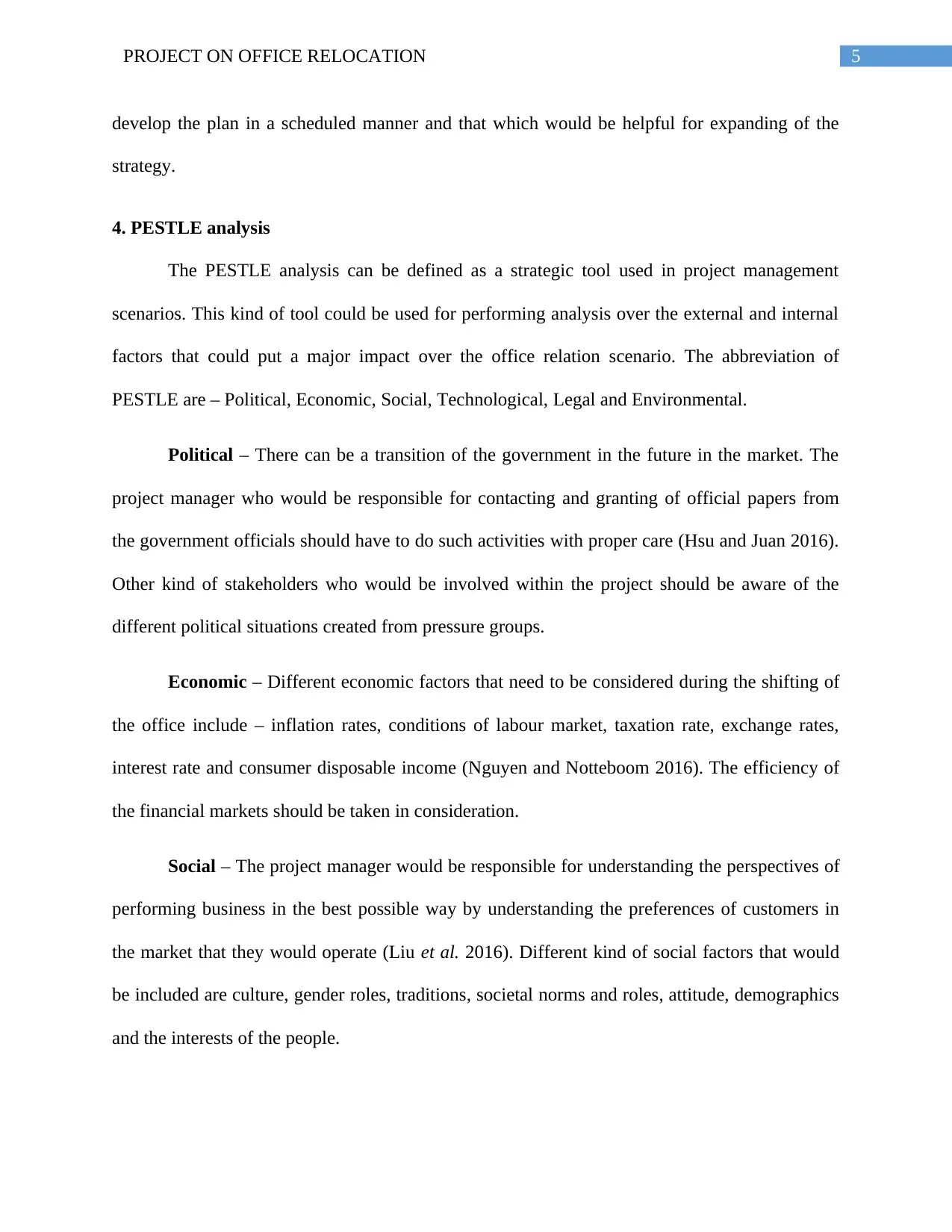
5PROJECT ON OFFICE RELOCATION
develop the plan in a scheduled manner and that which would be helpful for expanding of the
strategy.
4. PESTLE analysis
The PESTLE analysis can be defined as a strategic tool used in project management
scenarios. This kind of tool could be used for performing analysis over the external and internal
factors that could put a major impact over the office relation scenario. The abbreviation of
PESTLE are – Political, Economic, Social, Technological, Legal and Environmental.
Political – There can be a transition of the government in the future in the market. The
project manager who would be responsible for contacting and granting of official papers from
the government officials should have to do such activities with proper care (Hsu and Juan 2016).
Other kind of stakeholders who would be involved within the project should be aware of the
different political situations created from pressure groups.
Economic – Different economic factors that need to be considered during the shifting of
the office include – inflation rates, conditions of labour market, taxation rate, exchange rates,
interest rate and consumer disposable income (Nguyen and Notteboom 2016). The efficiency of
the financial markets should be taken in consideration.
Social – The project manager would be responsible for understanding the perspectives of
performing business in the best possible way by understanding the preferences of customers in
the market that they would operate (Liu et al. 2016). Different kind of social factors that would
be included are culture, gender roles, traditions, societal norms and roles, attitude, demographics
and the interests of the people.
develop the plan in a scheduled manner and that which would be helpful for expanding of the
strategy.
4. PESTLE analysis
The PESTLE analysis can be defined as a strategic tool used in project management
scenarios. This kind of tool could be used for performing analysis over the external and internal
factors that could put a major impact over the office relation scenario. The abbreviation of
PESTLE are – Political, Economic, Social, Technological, Legal and Environmental.
Political – There can be a transition of the government in the future in the market. The
project manager who would be responsible for contacting and granting of official papers from
the government officials should have to do such activities with proper care (Hsu and Juan 2016).
Other kind of stakeholders who would be involved within the project should be aware of the
different political situations created from pressure groups.
Economic – Different economic factors that need to be considered during the shifting of
the office include – inflation rates, conditions of labour market, taxation rate, exchange rates,
interest rate and consumer disposable income (Nguyen and Notteboom 2016). The efficiency of
the financial markets should be taken in consideration.
Social – The project manager would be responsible for understanding the perspectives of
performing business in the best possible way by understanding the preferences of customers in
the market that they would operate (Liu et al. 2016). Different kind of social factors that would
be included are culture, gender roles, traditions, societal norms and roles, attitude, demographics
and the interests of the people.
⊘ This is a preview!⊘
Do you want full access?
Subscribe today to unlock all pages.

Trusted by 1+ million students worldwide
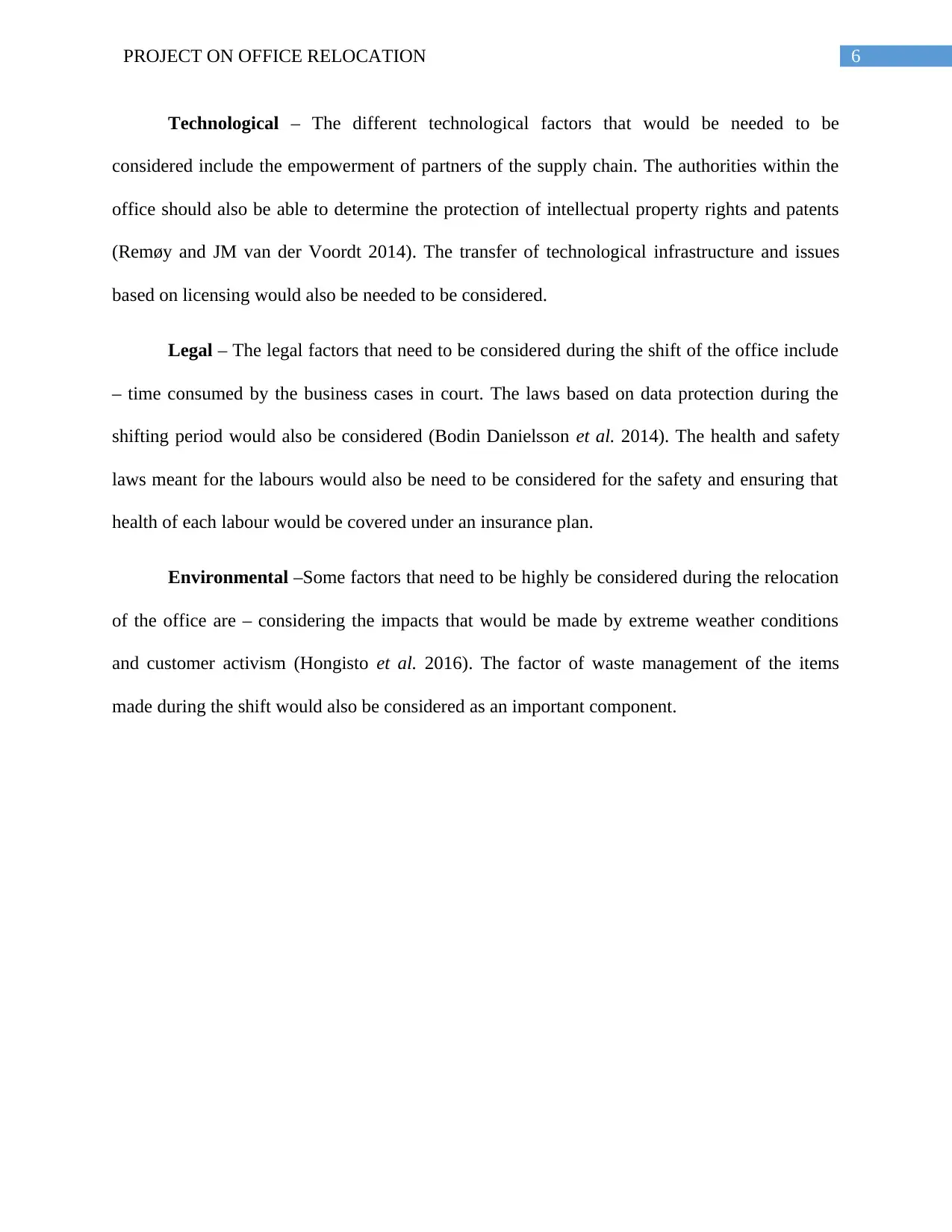
6PROJECT ON OFFICE RELOCATION
Technological – The different technological factors that would be needed to be
considered include the empowerment of partners of the supply chain. The authorities within the
office should also be able to determine the protection of intellectual property rights and patents
(Remøy and JM van der Voordt 2014). The transfer of technological infrastructure and issues
based on licensing would also be needed to be considered.
Legal – The legal factors that need to be considered during the shift of the office include
– time consumed by the business cases in court. The laws based on data protection during the
shifting period would also be considered (Bodin Danielsson et al. 2014). The health and safety
laws meant for the labours would also be need to be considered for the safety and ensuring that
health of each labour would be covered under an insurance plan.
Environmental –Some factors that need to be highly be considered during the relocation
of the office are – considering the impacts that would be made by extreme weather conditions
and customer activism (Hongisto et al. 2016). The factor of waste management of the items
made during the shift would also be considered as an important component.
Technological – The different technological factors that would be needed to be
considered include the empowerment of partners of the supply chain. The authorities within the
office should also be able to determine the protection of intellectual property rights and patents
(Remøy and JM van der Voordt 2014). The transfer of technological infrastructure and issues
based on licensing would also be needed to be considered.
Legal – The legal factors that need to be considered during the shift of the office include
– time consumed by the business cases in court. The laws based on data protection during the
shifting period would also be considered (Bodin Danielsson et al. 2014). The health and safety
laws meant for the labours would also be need to be considered for the safety and ensuring that
health of each labour would be covered under an insurance plan.
Environmental –Some factors that need to be highly be considered during the relocation
of the office are – considering the impacts that would be made by extreme weather conditions
and customer activism (Hongisto et al. 2016). The factor of waste management of the items
made during the shift would also be considered as an important component.
Paraphrase This Document
Need a fresh take? Get an instant paraphrase of this document with our AI Paraphraser
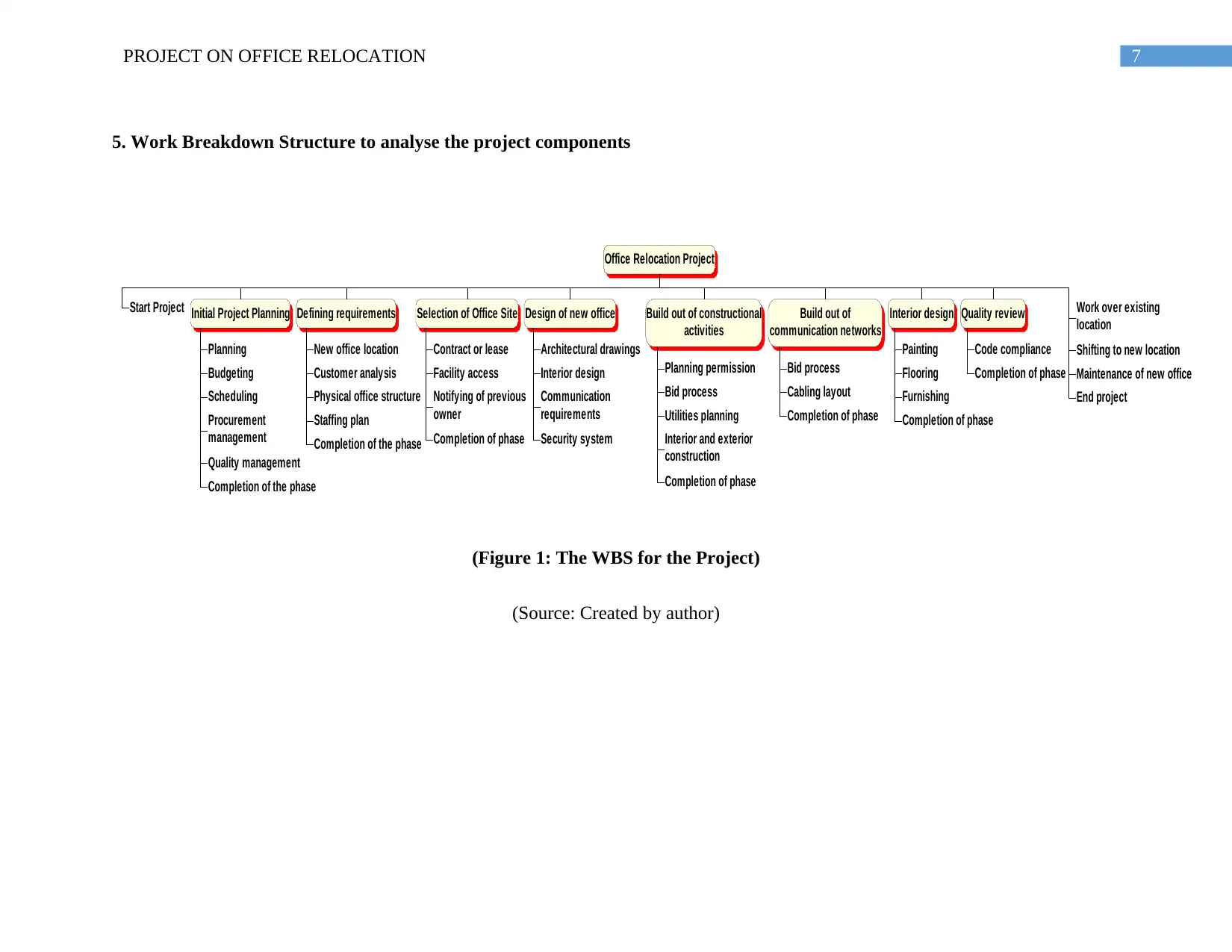
7PROJECT ON OFFICE RELOCATION
5. Work Breakdown Structure to analyse the project components
Office Relocation Project
Start Project Initial Project Planning
Planning
Budgeting
Scheduling
Procurement
management
Quality management
Completion of the phase
Defining requirements
New office location
Customer analysis
Physical office structure
Staffing plan
Completion of the phase
Selection of Office Site
Contract or lease
Facility access
Notifying of previous
owner
Completion of phase
Design of new office
Architectural drawings
Interior design
Communication
requirements
Security system
Build out of constructional
activities
Planning permission
Bid process
Utilities planning
Interior and exterior
construction
Completion of phase
Build out of
communication networks
Bid process
Cabling layout
Completion of phase
Interior design
Painting
Flooring
Furnishing
Completion of phase
Quality review
Code compliance
Completion of phase
Work over existing
location
Shifting to new location
Maintenance of new office
End project
(Figure 1: The WBS for the Project)
(Source: Created by author)
5. Work Breakdown Structure to analyse the project components
Office Relocation Project
Start Project Initial Project Planning
Planning
Budgeting
Scheduling
Procurement
management
Quality management
Completion of the phase
Defining requirements
New office location
Customer analysis
Physical office structure
Staffing plan
Completion of the phase
Selection of Office Site
Contract or lease
Facility access
Notifying of previous
owner
Completion of phase
Design of new office
Architectural drawings
Interior design
Communication
requirements
Security system
Build out of constructional
activities
Planning permission
Bid process
Utilities planning
Interior and exterior
construction
Completion of phase
Build out of
communication networks
Bid process
Cabling layout
Completion of phase
Interior design
Painting
Flooring
Furnishing
Completion of phase
Quality review
Code compliance
Completion of phase
Work over existing
location
Shifting to new location
Maintenance of new office
End project
(Figure 1: The WBS for the Project)
(Source: Created by author)
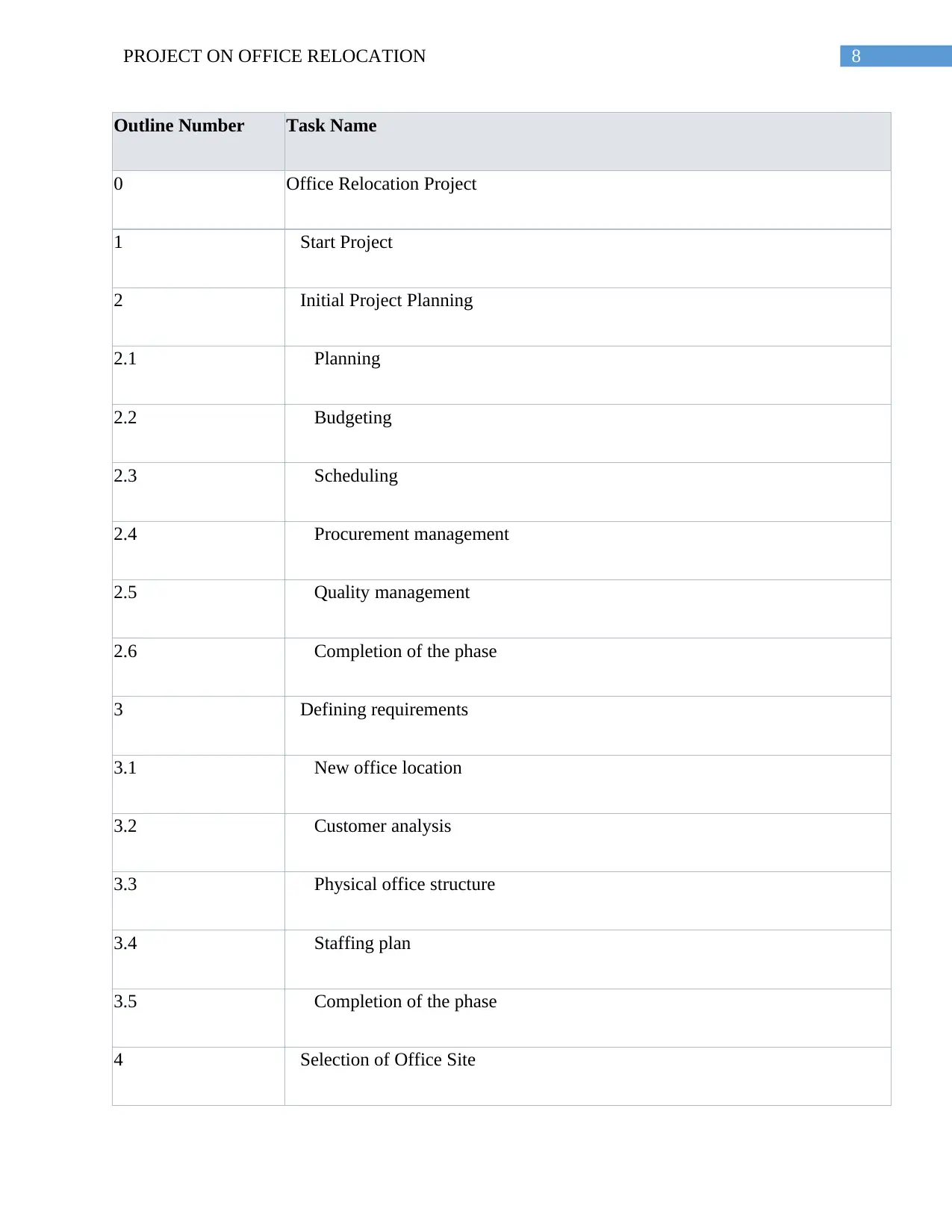
8PROJECT ON OFFICE RELOCATION
Outline Number Task Name
0 Office Relocation Project
1 Start Project
2 Initial Project Planning
2.1 Planning
2.2 Budgeting
2.3 Scheduling
2.4 Procurement management
2.5 Quality management
2.6 Completion of the phase
3 Defining requirements
3.1 New office location
3.2 Customer analysis
3.3 Physical office structure
3.4 Staffing plan
3.5 Completion of the phase
4 Selection of Office Site
Outline Number Task Name
0 Office Relocation Project
1 Start Project
2 Initial Project Planning
2.1 Planning
2.2 Budgeting
2.3 Scheduling
2.4 Procurement management
2.5 Quality management
2.6 Completion of the phase
3 Defining requirements
3.1 New office location
3.2 Customer analysis
3.3 Physical office structure
3.4 Staffing plan
3.5 Completion of the phase
4 Selection of Office Site
⊘ This is a preview!⊘
Do you want full access?
Subscribe today to unlock all pages.

Trusted by 1+ million students worldwide
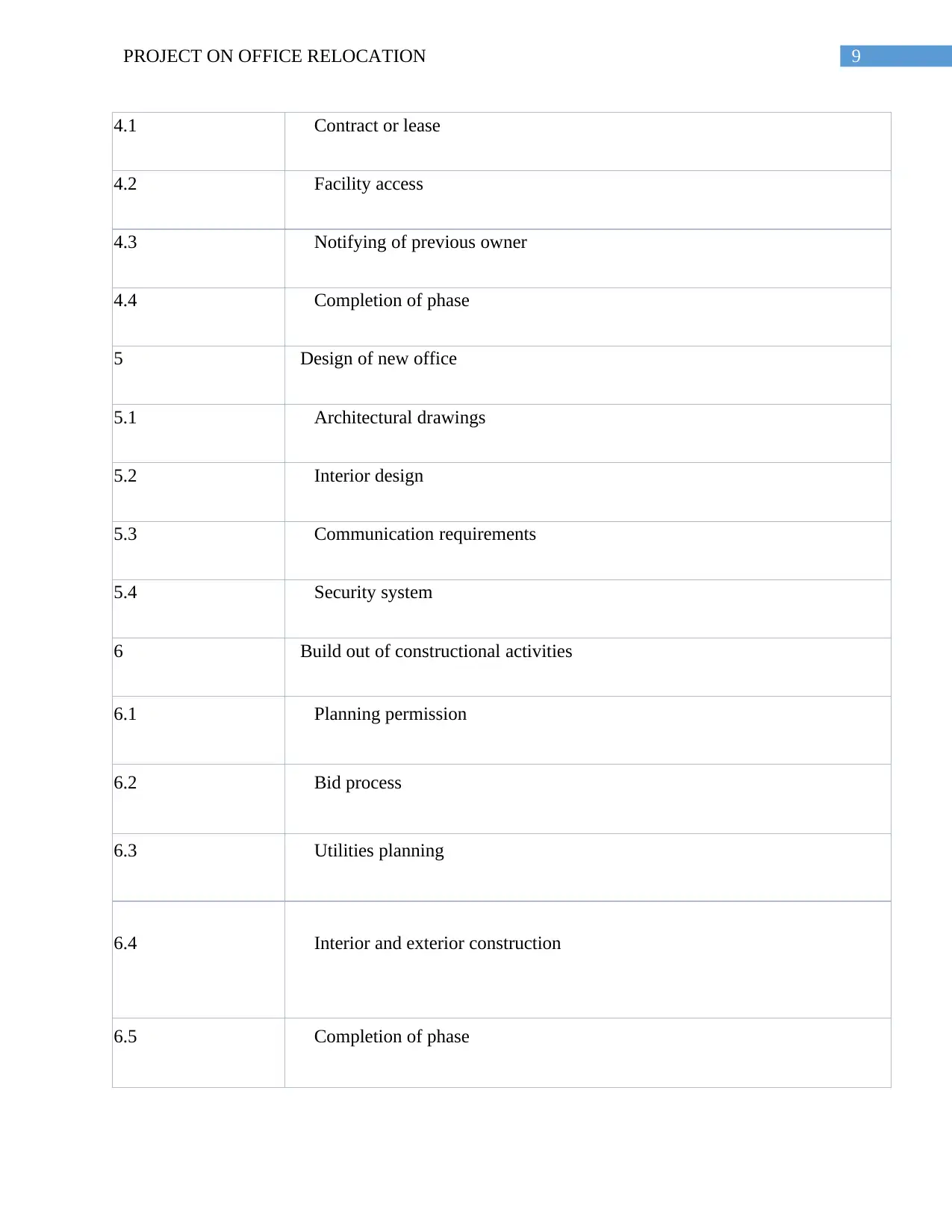
9PROJECT ON OFFICE RELOCATION
4.1 Contract or lease
4.2 Facility access
4.3 Notifying of previous owner
4.4 Completion of phase
5 Design of new office
5.1 Architectural drawings
5.2 Interior design
5.3 Communication requirements
5.4 Security system
6 Build out of constructional activities
6.1 Planning permission
6.2 Bid process
6.3 Utilities planning
6.4 Interior and exterior construction
6.5 Completion of phase
4.1 Contract or lease
4.2 Facility access
4.3 Notifying of previous owner
4.4 Completion of phase
5 Design of new office
5.1 Architectural drawings
5.2 Interior design
5.3 Communication requirements
5.4 Security system
6 Build out of constructional activities
6.1 Planning permission
6.2 Bid process
6.3 Utilities planning
6.4 Interior and exterior construction
6.5 Completion of phase
Paraphrase This Document
Need a fresh take? Get an instant paraphrase of this document with our AI Paraphraser
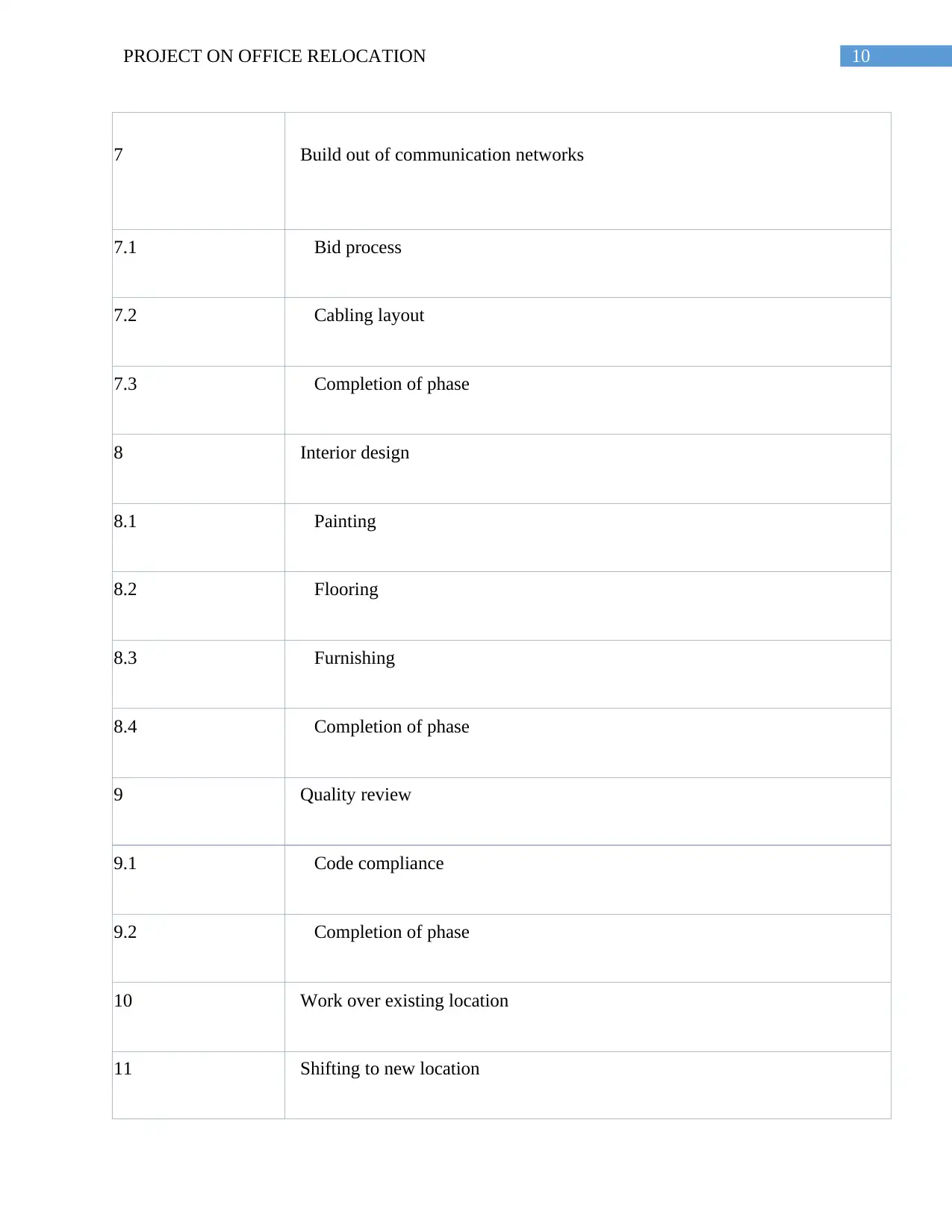
10PROJECT ON OFFICE RELOCATION
7 Build out of communication networks
7.1 Bid process
7.2 Cabling layout
7.3 Completion of phase
8 Interior design
8.1 Painting
8.2 Flooring
8.3 Furnishing
8.4 Completion of phase
9 Quality review
9.1 Code compliance
9.2 Completion of phase
10 Work over existing location
11 Shifting to new location
7 Build out of communication networks
7.1 Bid process
7.2 Cabling layout
7.3 Completion of phase
8 Interior design
8.1 Painting
8.2 Flooring
8.3 Furnishing
8.4 Completion of phase
9 Quality review
9.1 Code compliance
9.2 Completion of phase
10 Work over existing location
11 Shifting to new location

11PROJECT ON OFFICE RELOCATION
12 Maintenance of new office
13 End project
6. Gantt chart for the project
The office relocation project would be planned as per the proper form of planning. The
different activities that are included within the Gantt chart are described as follows:
12 Maintenance of new office
13 End project
6. Gantt chart for the project
The office relocation project would be planned as per the proper form of planning. The
different activities that are included within the Gantt chart are described as follows:
⊘ This is a preview!⊘
Do you want full access?
Subscribe today to unlock all pages.

Trusted by 1+ million students worldwide
1 out of 25
Related Documents
Your All-in-One AI-Powered Toolkit for Academic Success.
+13062052269
info@desklib.com
Available 24*7 on WhatsApp / Email
![[object Object]](/_next/static/media/star-bottom.7253800d.svg)
Unlock your academic potential
Copyright © 2020–2025 A2Z Services. All Rights Reserved. Developed and managed by ZUCOL.





